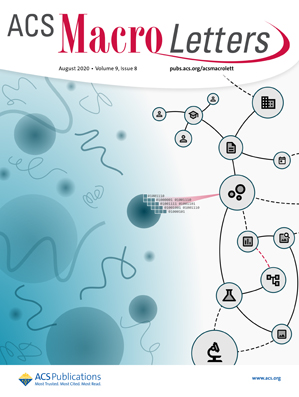Intrinsic Doping and Electrostatic Complexation of Sulfonated Poly(3,4-ethylenedioxythiophenes) (PEDOTs).
IF 5.2
Q1 POLYMER SCIENCE
引用次数: 0
Abstract
Self-doped conjugated polymers represent a compelling strategy for forming conductive electrostatically complexed polymer blends without the need for additional processing steps for electronic doping. Although self-doped polymers simplify processing, fundamental questions remain about structure-property relationships and the role of doping in electrostatic complexation. A class of sulfonated PEDOT derivatives was investigated to study their self-doping behavior and the ability to form electrostatically mediated complexes with cationic polyelectrolytes. Remarkably, even a subtle change in side chain architecture (differing by only a single carbon) influenced the electrical conductivity, with the shorter side chain exhibiting values up to ≈500 S cm-1, roughly 1000 times higher than its longer-chain counterpart. Comprehensive spectroscopic and electrochemical analyses were performed to gain insight into the origin of the behavior. These self-doped conjugated polyelectrolytes maintain high electrical conductivity (≈300 S cm-1), even after complexation with an insulating polyelectrolyte. The phase behavior of complexation revealed the ability to define an effective charge fraction of ionic groups per monomer that can guide the design of electrostatically complex conjugated polyelectrolytes.磺化聚(3,4-乙烯二氧噻吩)(PEDOTs)的本征掺杂和静电络合。
自掺杂共轭聚合物代表了一种引人注目的策略,形成导电的静电络合聚合物共混物,而不需要额外的电子掺杂处理步骤。虽然自掺杂聚合物简化了加工过程,但关于结构-性能关系和掺杂在静电络合中的作用的基本问题仍然存在。研究了一类磺化PEDOT衍生物的自掺杂行为以及与阳离子聚电解质形成静电介导配合物的能力。值得注意的是,即使侧链结构的细微变化(仅相差一个碳)也会影响电导率,较短侧链的电导率高达≈500 S cm-1,约为较长链的1000倍。进行了全面的光谱和电化学分析,以深入了解行为的起源。这些自掺杂共轭聚电解质即使在与绝缘聚电解质络合后也能保持高导电性(≈300 S cm-1)。络合的相行为揭示了确定每个单体离子基团有效电荷分数的能力,这可以指导静电络合共轭聚电解质的设计。
本文章由计算机程序翻译,如有差异,请以英文原文为准。
求助全文
约1分钟内获得全文
求助全文
来源期刊
CiteScore
10.40
自引率
3.40%
发文量
209
审稿时长
1 months
期刊介绍:
ACS Macro Letters publishes research in all areas of contemporary soft matter science in which macromolecules play a key role, including nanotechnology, self-assembly, supramolecular chemistry, biomaterials, energy generation and storage, and renewable/sustainable materials. Submissions to ACS Macro Letters should justify clearly the rapid disclosure of the key elements of the study. The scope of the journal includes high-impact research of broad interest in all areas of polymer science and engineering, including cross-disciplinary research that interfaces with polymer science.
With the launch of ACS Macro Letters, all Communications that were formerly published in Macromolecules and Biomacromolecules will be published as Letters in ACS Macro Letters.

 求助内容:
求助内容: 应助结果提醒方式:
应助结果提醒方式:


